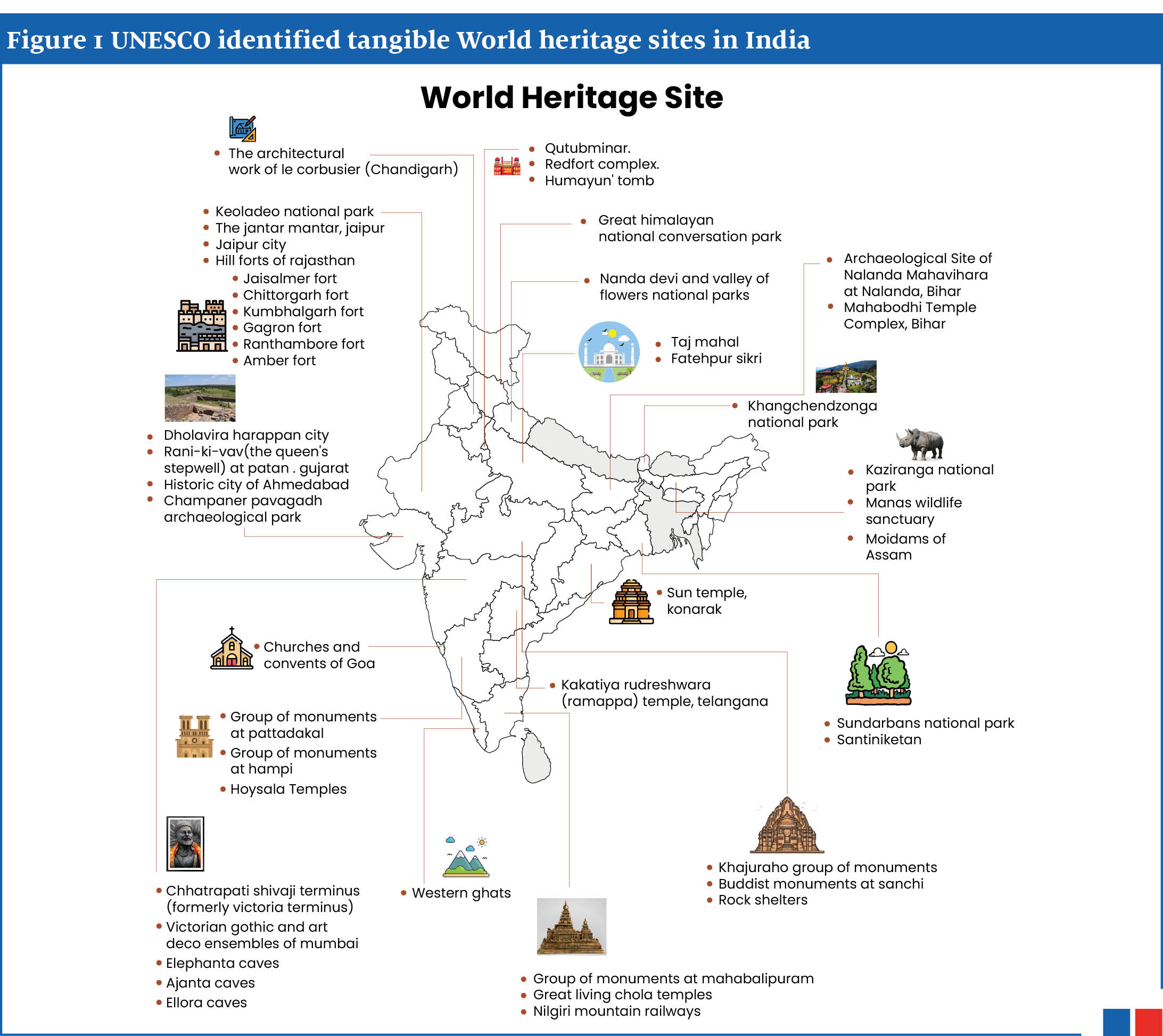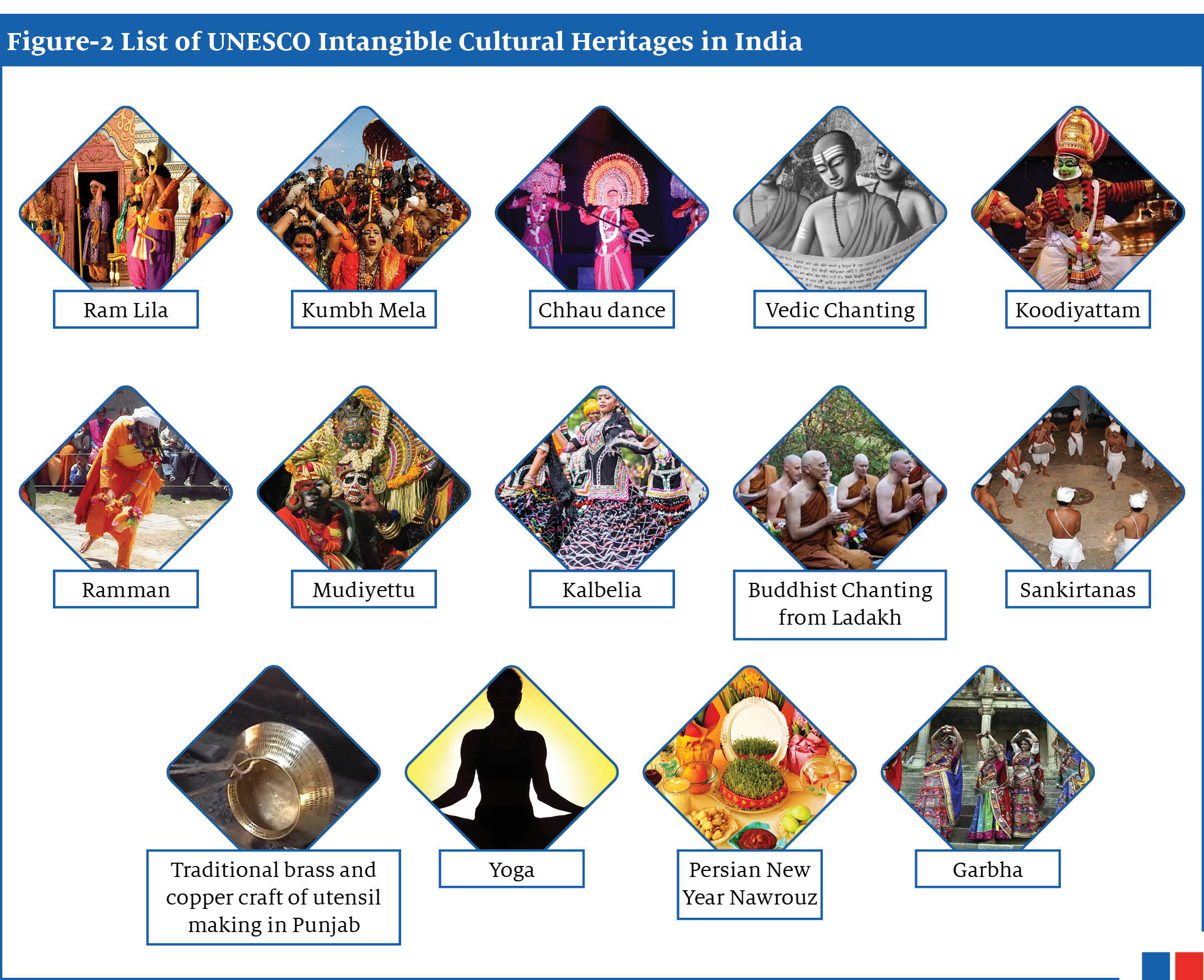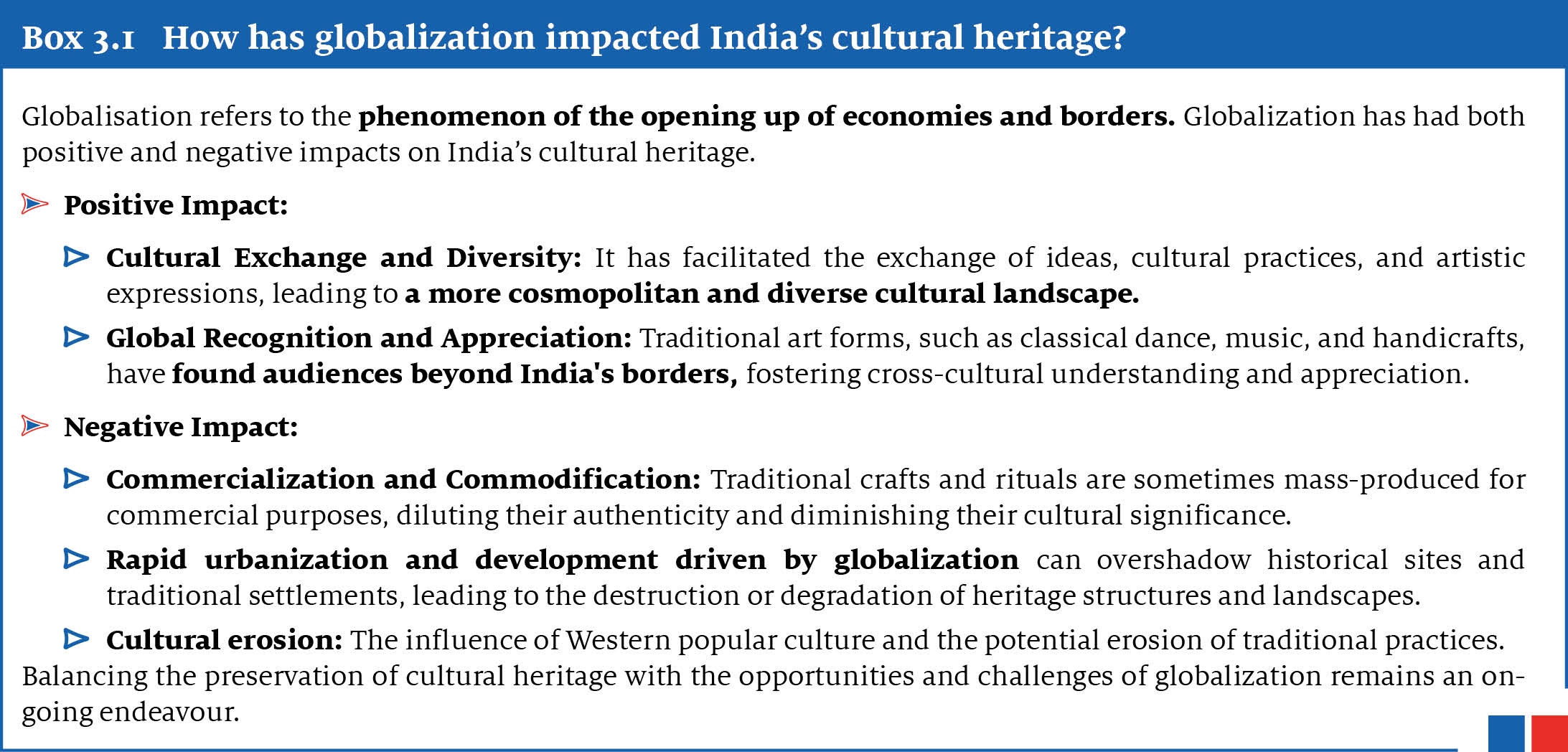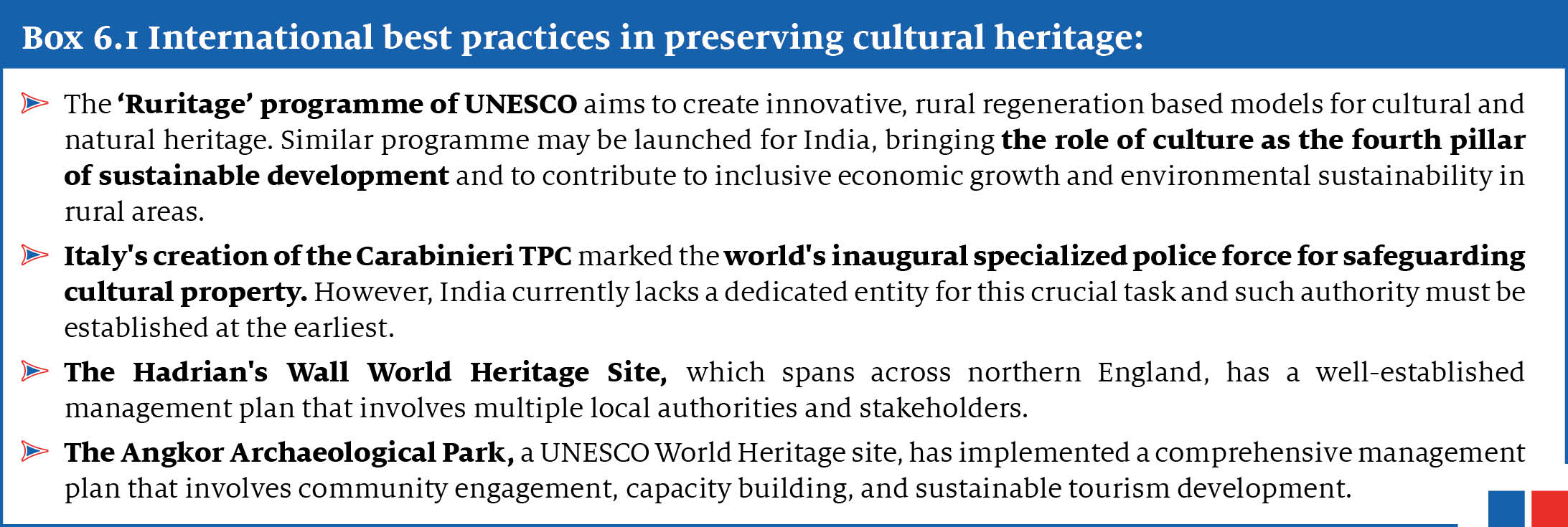Introduction
Introduction
India, often described as a subcontinent within a country, has a cultural heritage that is both rich and diverse. This heritage reflects the country's deep and varied history. From the ancient Indus Valley Civilization to the vibrant culture of today, India's story is one of blended traditions, beliefs, and arts, shaped by its many ethnic groups and religions. Each cultural artefact in India is a piece of the country's collective memory, connecting the present to the past. However, in today's globalized world, preserving this heritage comes with challenges. Efforts to conserve and interpret cultural artefacts must keep pace with the pressures of modernization. Despite these challenges, India's cultural legacy continues to be a source of unity and strength, transcending the bounds of time.
1. What is cultural heritage?
What is cultural heritage?
Cultural Heritage is an expression of the ways of living developed by a community and passed on from generation to generation, including customs, practices, objects, artistic expressions and values.
UNESCO defines Cultural Heritage as ‘both a product and a process, which provides societies with a wealth of resources that are inherited from the past, created in the present and bestowed for the benefit of future generations’.
Types of Cultural Heritage
The cultural heritage of Indigenous peoples is considered in two ways i.e. tangible and intangible. Both aspects are strongly interconnected to each other, and to Country (broadly or specific to a place).
- Tangible Cultural Heritage: refers to physical artifacts produced, maintained and transmitted intergenerationally in a society.
- It includes artistic creations, built heritage such as buildings and monuments, and other physical or tangible products of human creativity.
- For e.g. Hill forts of Rajasthan, Sun temple, etc.
- Intangible Cultural Heritage: indicates the practices, representations, expressions, knowledge, skills – as well as the instruments, objects, artefacts and cultural spaces associated therewith.
- For e.g. The tradition of Vedic chanting, Ramlila, Kumbh Mela, etc.


2. What are the key elements of India's cultural heritage?
India’s cultural heritage is not only one of the most ancient but it is also one of the most extensive and varied. Due to its rich and precious Cultural and Natural heritages, India is came to be known as the land of great wonders and diversities. The key elements of India’s cultural heritage are
- Indian Knowledge Systems: It comprises of Jnan, Vignan, and Jeevan Darshan that have evolved out of experience, observation, experimentation, and rigorous analysis. For E.g., Yoga, Ayurveda, etc.
- Indian folk culture: It is vibrant mixture of traditions, art forms, and customs passed down through generations continuously from Indus Valley Civilization.
- It encompasses diverse regional practices, including intricate handicrafts, and lively music and dance. For e.g., Lavani dance of Maharashtra, Madhubani painting of Bihar, etc.
- Art and Architecture: India is rich in traditions of painting, sculpture, literature, and poetry which continue to thrive.
- India boasts a rich architectural heritage with a blend of ancient and modern structures. Iconic landmarks like the Taj Mahal, Qutub Minar, Jaipur's palaces, and ancient temples like Khajuraho and Ellora showcase India's architectural prowess.
- Festivals: India is a land of festivals, and there is always a celebration taking place somewhere in the country for e.g. hornbill festival.
- Religious Diversity: India, the birthplace of Hinduism, Buddhism, Jainism, and Sikhism, also hosts significant Muslim, Christian, Jewish, and other religious populations.
- Languages and Scripts: India is a linguistically diverse nation with over 1,600 languages spoken. The Constitution recognizes 22 official languages. Each state has its own official language(s).
- Social and cultural practices: India is unlike any other major civilization in its complexity and diversity; in fact, it is more akin to a region as diverse as Europe than a nation-state.
- Rituals related to marriage, birth, death, and religious ceremonies are different in different part of India.
3. What is the role of India's cultural heritage in national development?
Understanding our cultural heritage gives us a better sense of our personal identity. It plays an essential role in our society by linking the past, the present and the future generation, as a basis for building a strong nation and national identity. Main role played by cultural heritage are:
- Social Cohesion and Identity:
- Cultural heritage binds people together, fostering a sense of shared identity and belonging as It transcends regional, linguistic, and religious boundaries,
- For e.g., the tradition of "Aarti," a Hindu ritual of worship involving the offering of light to deities, is performed daily in temples across India.
- Cultural heritage binds people together, fostering a sense of shared identity and belonging as It transcends regional, linguistic, and religious boundaries,
- Economic Impact:
- Heritage economics is an evolving field with enormous potential in terms of sustainable development.
- Heritage items, such as historic buildings, are classified as cultural capital as they may not only have a potential sale price as real estate, but also have other significance that cannot be expressed in monetary terms, such as an ancient engineering concept.
- Job Creation: Heritage-related services, such as guided tours, restoration, and cultural events, create employment opportunities.
- For e.g., Iconic heritage sites like the Taj Mahal, Ajanta Caves, and Khajuraho Group of Monuments attract millions of visitors annually.
- Craftsmanship, handlooms, and indigenous arts generate employment and income for artisans and communities.
- For e.g., Toy industry is a labour-oriented industry based on master craftsmanship and creative designing.
- Cultural exports, including music, dance, and handicrafts, enhance India’s global presence and contribute to foreign exchange earnings.
- Heritage economics is an evolving field with enormous potential in terms of sustainable development.
- Education and Innovation: Ancient texts like the Vedas, Upanishads, and Bhagavad Gita offer profound knowledge and ethics, while Yoga and Ayurveda provide holistic health.
- Cultural heritage fosters creativity, innovation, and interdisciplinary thinking.
- Environmental Conservation: India's cultural heritage, intertwined with natural landscapes like the Ellora Caves, Sundarbans National Park and Sacred groves, promotes ecosystem protection and embeds sustainable practices in traditions.
- Achieving Sustainable Development Goals (SDGs): The G20 New Delhi Leaders’ Declaration highlights culture's role in achieving SDGs. Artists, through movements like Delhi's street art movement, raise awareness and drive social change on climate, waste, and gender issues.
- Soft Power and Cultural Diplomacy:
- Culture acts as a cohesive agent for growth and development in international relations. Two Indian philosophies, viz. Vasudhaiva Kutumbhakam and Atithi Devo Bhava, have always been part of Indian traditions.
- Cultural exchanges and Initiatives like the International Day of Yoga exemplify India’s cultural influence.

4. What are the Government Initiatives for heritage conservation and Cultural Revival?
The Government is combining development with heritage preservation, instilling a deeper sense of history in the younger generation. The government is focusing on cultivating an appreciation for India’s civilizational heritage, that will foster a transformative shift in society. Major government initiatives are
Cultural Heritage Conservation and Promotion:
- The Kashi Culture Pathway, adopted at the G20 Culture Ministerial Meeting in 2023, addresses threats to cultural heritage.
- New Institution: The government has decided to set up ‘Indian Institute of Heritage’ at Noida to focus on conservation and research in India‘s rich tangible heritage.
- The PRASAD Pilgrimage Rejuvenation and Spiritual Augmentation Drive) and HRIDAY scheme (Heritage City Development and Augmentation Yojana) aims to develop and beautify pilgrimage destinations and to preserve and revitalise the heritage cities of India.
- Under the Swadesh Darshan Scheme: 15 themes have been identified for developing theme based circuits in which one theme is Heritage Circuit such as Madhya Pradesh Indore-Maheshwar-Omkareshwar.
- The ‘Adopt a Heritage’ project aims to develop the heritage sites/monuments, making them tourist friendly and enhancing the tourism potential. This involves active participation of individuals, agencies by becoming “Monument Mitra” through the concept of Vision Bidding.
- PM Vishwakarma Yojana to create an ecosystem of support for traditional artisans and to enable them to flourish in their crafts and contribute to the preservation of India's rich cultural heritage.
Education and Skill Development Initiatives:
- Protecting natural heritage: Centre administers ‘Scheme of Financial Assistance for the Preservation and Development of Cultural Heritage of the Himalayas‘ that provides 10 lakh per year to schools or colleges to study and research on Himalayan cultural heritage.
- Kashi Tamil Sangamam was organised by the Ministry of Education in 2022 to celebrate, reaffirm and rediscover the age-old links between Tamil Nadu and Varanasi.
- Toy Cluster Programme- To streamline this sector, the government announced the ‘Product Specific Industrial Cluster Development Programme’ in 2020 to build toy clusters in dedicated SEZs and help them become customised, self-sustained ecosystems catering to export markets.
- Know India Programme, a three-week orientation programme by the MEA, has created a unique forum for youth diaspora to acquaint themselves with Indian Culture.
Institutional measures to protect heritage
- The Archaeological Survey of India (ASI): Founded in 1861 by Alexander Cunningham. Currently headquartered in New Delhi, Under Ministry of Culture.
- It is a premier organisation that is responsible for archaeological research and the conservation and preservation of cultural historical monuments in the country.
- Indira Gandhi National Centre for the Arts (IGNCA): An autonomous institution under the Ministry of Culture focusing on the preservation and promotion of art and culture.
- Preserving Intangible Heritage: Institutions like the Sangeet Natak Akademi and Lalit Kala Akademi actively safeguard and promote these intangible treasures.
International and Technological Initiatives
- India has signed several bilateral agreements with other countries such as Israel, Japan, and France for Cultural Exchanges and Promotion.
- Indian Council for Cultural Relations (ICCR): under Ministry of External Affairs to promote cultural exchanges with other countries and people.
- Culture hubs: Transportation Hubs including Metro stations and Airports in India have also volunteered in preserving and sensitising the passenger about various Art forms.
- Netflix and UNESCO have recently come together to celebrate the rich cultural heritage of India, both tangible and intangible, through a cartooned series titled Mighty Little Bheem.

5. What are the threats to India's diverse cultural heritage?
India has suffered over the ages, with its heritage not only plundered but also destroyed irrevocably, many a times, by foreign invaders. In the present time there are threats such as
- Issues with the present legal framework
- Registration of Antiquities: The AAT Act, 1972, provided that the Central Government may specify those antiquities which should be registered under the Act. As per the extant provisions, registration of the artefacts was not mandatory.
- Further, the registration process was not based on scientific testing but relied on discretion. Hence, its accuracy may be ambiguous and subject to disputes.
- Digitisation and documentation of Art objects: Documentation of art heritage is a gaping hole in efforts to preserve and safeguard heritage.
- Repatriation of artifacts: The ASI stated that the restitution of the objects which were taken out of the country prior to the enforcement of the Act was not within its control.
- Hence they had to depend on the goodwill of other countries for their restitution.
- Registration of Antiquities: The AAT Act, 1972, provided that the Central Government may specify those antiquities which should be registered under the Act. As per the extant provisions, registration of the artefacts was not mandatory.
- Lack of integrated planning: Many archaeological sites have been destroyed or explored due to developmental activities, emphasizing the need for cultural resource management.
- For instance, in 2020, evidence of the Ochre Coloured Pottery (OCP) culture (2100-1900 BCE) emerged in Chandayan, Uttar Pradesh. However, due to the land still being under cultivation, the Archaeological Survey of India (ASI) has been unable to commence excavation.
- Issue with ASI: According to parliamentary standing committee, ASI working is plagued by lack of centralised monitoring of excavation activities, lack of action plans, and insufficient budget allocation.
- Lack of Coordination: Inadequate coordination between central and state bodies impairs heritage conservation efforts. For instance, the Elephanta Caves have faced neglect and deterioration.
- Natural Disasters and changing climate: India's tropical climate leads to extreme temperatures, humidity, air conditions, and contaminants which is changing due to rise in temperature
- For e.g. red fort was flooded recently due to flood in Yamuna river, effects of pollution in Taj mahal, etc.
- Treats to performing art: Financial constraints, a lack of institutional support, and waning enthusiasm among the younger generation are hampering preforming art such as Tamasha, thali ki Ramayana, etc.
- Illicit trafficking of cultural property driven by greed and lack of heritage appreciation, deprive nations of their heritage and impede archaeological research.
- For example, Bronze Nataraja statues smuggled from Tamil Nadu temples are linked to organized crimes, money laundering, and terrorist financing.

6. What are the measures required to preserve and celebrate India’s cultural heritage?
India's cultural heritage is a vast and diverse treasure that requires concerted efforts to preserve and celebrate. A comprehensive approach to safeguarding this heritage involves several key measures:
- Revamping ASI: It can be provided with better funding and ensure that all the conservation processes employed at the Centrally protected monuments are backed by well-documented scientific research.
- National Database: Collaboration between ISRO and the Ministry of Culture should lead to a comprehensive, GIS-based national database of heritage sites, ensuring efficient preservation.
- An overarching management plan is required to revive the heritage structures with creating a National Archaeological Database at the outset.
- Use of Technology: Implement advanced technologies like Photogrammetry, 3D Laser scanning, LiDAR, Block chain technology and Satellite Remote Sensing Surveys in documentation, surveys, excavation, and conservation efforts.
- Excavation and Exploration of Archaeological Sites: Draft of Excavation and Exploration Policy to be finalized and adopted after public discussion and Archaeology to be recognised as a separate Cadre as suggested by NITI Aayog.
- Heritage Tourism and Education: Promote heritage tourism to preserve cultural and historic resources while creating economic opportunities and raising awareness. The guidelines of the National Conservation policy(given below )need to be implemented vigorously.
- An archaeological site should be subjected to minimum - whilst only necessary - interventions so as to maintain its authenticity and integrity.
- Conservation should be treated as a multi-disciplinary enterprise that focuses on developing holistic solutions
- Disaster Management Plan should be made as an important pre-requisite of the Conservation Plan for a monument.
- Funding: From ‘crowd funding’ to ‘community funding’, new funding models can be explored. Also, The ASI or State Archaeology Departments need to identify projects that could be carried out in rural areas with MNERGA funds.
- Dissemination of cultural heritage information to the Citizens: A national campaign like the Swachh Bharat Abhiyan can be started to leverage behavioural economics in changing the perception of citizens and instilling a sense of pride towards our composite heritage.
- Involvement of private sector: National level, State level, District level competitions focusing on culture can be promoted regularly.
- Private sector can also be encouraged to promote culture through their CSR programs.
- Preserving performing arts: Developing the idea of a specific museum (Living Home) of live performing arts at the regional level is needed.
- Documentation and the establishment of a performing arts council at the regional level to ensure the substantial existence of the art form.

Conclusion
India's cultural heritage, a vibrant tapestry of diversity and tradition, stands as a beacon of pride and inspiration. Yet, its full potential remains untapped due to a lack of awareness and the challenges of unethical appropriation and trafficking. Embracing the four Cs - Culture, Creativity, Commerce, and Collaboration - is key to safeguarding and promoting India's rich heritage, ensuring its preservation for future generations and global appreciation, positioning India as a cultural superpower.
- Tags :
- Art and Culture
- UNESCO World Heritage Sites
- Cultural Heritage





